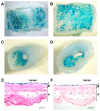In Vivo Gene Transfer to the Rabbit Common Carotid Artery Endothelium
- PMID: 29782016
- PMCID: PMC6101119
- DOI: 10.3791/56982
In Vivo Gene Transfer to the Rabbit Common Carotid Artery Endothelium
Abstract
The goal of this method is to introduce a transgene into the endothelium of isolated segments of both rabbit common carotid arteries. The method achieves focal endothelial-selective transgenesis, thereby allowing an investigator to determine the biological roles of endothelial-expressed transgenes and to quantify the in vivo transcriptional activity of DNA sequences in large artery endothelial cells. The method uses surgical isolation of rabbit common carotid arteries and an arteriotomy to deliver a transgene-expressing viral vector into the arterial lumen. A short incubation period of the vector in the lumen, with subsequent aspiration of the lumen contents, is sufficient to achieve efficient and durable expression of the transgene in the endothelium, with no detectable transduction or expression outside of the isolated arterial segment. The method allows assessment of the biological activities of transgene products both in normal arteries and in models of human vascular disease, while avoiding systemic effects that could be caused either by targeting gene delivery to other sites (e.g. the liver) or by the alternative approach of delivering genetic constructs to the endothelium by germ line transgenesis. Application of the method is limited by the need for a skilled surgeon and anesthetist, a well-equipped operating room, the costs of purchasing and housing rabbits, and the need for expertise in gene-transfer vector construction and use. Results obtained with this method include: transgene-related alterations in arterial structure, cellularity, extracellular matrix, or vasomotor function; increases or reductions in arterial inflammation; alterations in vascular cell apoptosis; and progression, retardation, or regression of diseases such as intimal hyperplasia or atherosclerosis. The method also allows measurement of the ability of native and synthetic DNA regulatory sequences to alter transgene expression in endothelial cells, providing results that include: levels of transgene mRNA, levels of transgene protein, and levels of transgene enzymatic activity.
Similar articles
-
A Rabbit Model of Durable Transgene Expression in Jugular Vein to Common Carotid Artery Interposition Grafts.J Vis Exp. 2018 Sep 10;(139):57231. doi: 10.3791/57231. J Vis Exp. 2018. PMID: 30247462 Free PMC article.
-
Acute host-mediated endothelial injury after adenoviral gene transfer in normal rabbit arteries: impact on transgene expression and endothelial function.Circ Res. 1998 Jun 29;82(12):1253-62. doi: 10.1161/01.res.82.12.1253. Circ Res. 1998. PMID: 9648721
-
Apo A-I (Apolipoprotein A-I) Vascular Gene Therapy Provides Durable Protection Against Atherosclerosis in Hyperlipidemic Rabbits.Arterioscler Thromb Vasc Biol. 2018 Jan;38(1):206-217. doi: 10.1161/ATVBAHA.117.309565. Epub 2017 Nov 9. Arterioscler Thromb Vasc Biol. 2018. PMID: 29122817 Free PMC article.
-
Gene transfer into vascular cells.J Am Coll Cardiol. 1991 May;17(6 Suppl B):189B-194B. doi: 10.1016/0735-1097(91)90957-b. J Am Coll Cardiol. 1991. PMID: 2016477 Review.
-
Gene therapy: designer promoters for tumour targeting.Trends Genet. 2000 Apr;16(4):174-81. doi: 10.1016/s0168-9525(99)01950-2. Trends Genet. 2000. PMID: 10729833 Review.
Cited by
-
Exosome-Mediated Transfer of X-Motif-Tagged Anti-MiR-33a-5p Antagomirs to the Medial Cells of Transduced Rabbit Carotid Arteries.Biology (Basel). 2024 Nov 24;13(12):965. doi: 10.3390/biology13120965. Biology (Basel). 2024. PMID: 39765632 Free PMC article.
-
Response by Dichek to Letter Regarding Article, "Jugular Vein Injection of High-Titer Lentiviral Vectors Does Not Transduce the Aorta".Arterioscler Thromb Vasc Biol. 2021 Apr;41(4):e240-e242. doi: 10.1161/ATVBAHA.121.315965. Epub 2021 Mar 24. Arterioscler Thromb Vasc Biol. 2021. PMID: 33760630 Free PMC article. No abstract available.
-
Spatial control of robust transgene expression in mouse artery endothelium under ultrasound guidance.Signal Transduct Target Ther. 2022 Jul 18;7(1):225. doi: 10.1038/s41392-022-01031-w. Signal Transduct Target Ther. 2022. PMID: 35843985 Free PMC article. No abstract available.
-
HDL-Based Therapy: Vascular Protection at All Stages.Biomedicines. 2023 Feb 27;11(3):711. doi: 10.3390/biomedicines11030711. Biomedicines. 2023. PMID: 36979690 Free PMC article. Review.
-
Overexpression of ABCA1 in Carotid Endothelium of Hyperlipidemic Rabbits Modulates Vascular Inflammation.Hum Gene Ther. 2025 Apr;36(7-8):750-764. doi: 10.1089/hum.2024.166. Epub 2025 Mar 20. Hum Gene Ther. 2025. PMID: 40111153
References
-
- Schneider DB, et al. Expression of Fas ligand in arteries of hypercholesterolemic rabbits accelerates atherosclerotic lesion formation. Arterioscler Thromb Vasc Biol. 2000;20:298–308. - PubMed
Publication types
MeSH terms
Grants and funding
LinkOut - more resources
Full Text Sources
Other Literature Sources
Medical





